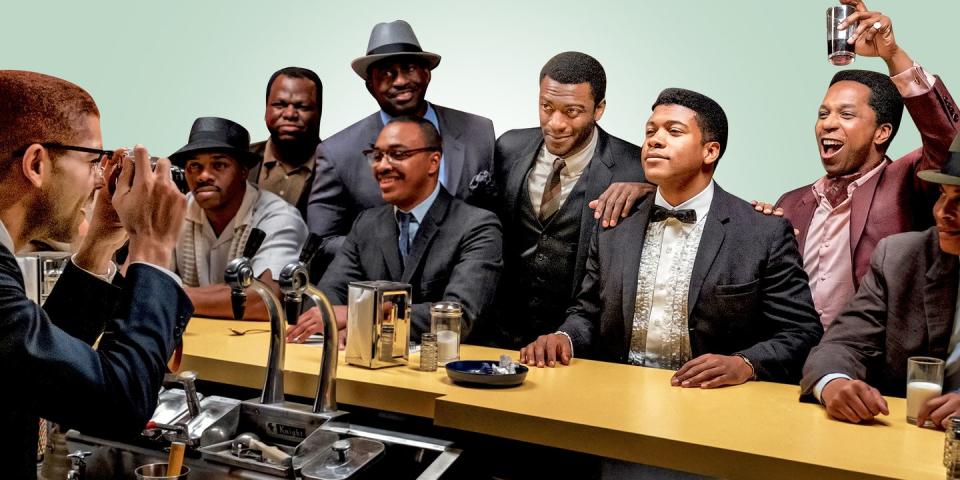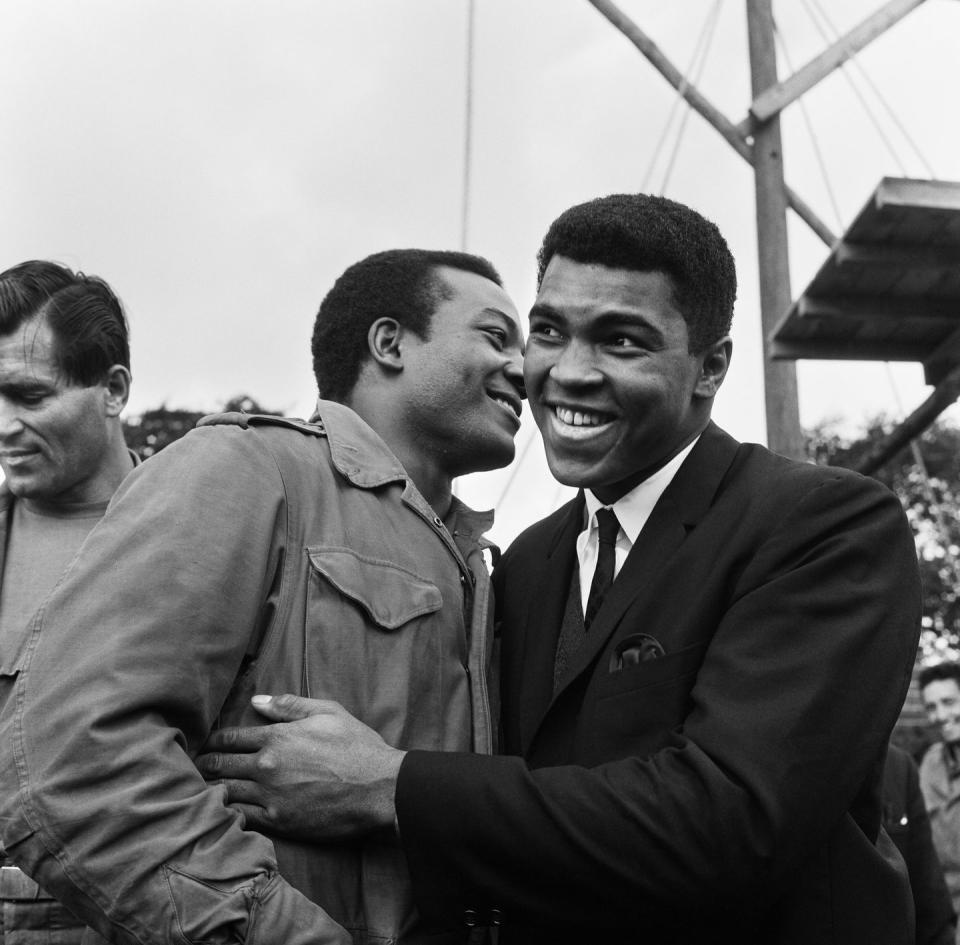There's an Incredible True Story Behind the Meeting of Black Legends in 'One Night in Miami'

The scenario—four Black legends from the worlds of music, sports, and politics, all gathered at the height of the Civil Rights struggle—seems almost too cinematic to be true. And while One Night in Miami, the Oscar buzz-generating new film directed by Academy Award- and Emmy-winning If Beale Street Could Talk and Watchmen star Regina King, is fictionalized, the broader strokes are true. In 1964, friends Malcolm X (Kingsley Ben-Adir), Cassius Clay (Eli Goree), Sam Cooke (Leslie Odom Jr.) and Jim Brown (Aldis Hodge) all spent an evening together in a Miami hotel in a once-in-a-lifetime meeting of legends.
The movie is an adaptation of a 2013 play by Kemp Powers, who also wrote the screenplay and recently served as co-writer and director of Pixar’s Soul. Powers was inspired to write the play after learning about this historic night in author Mike Marqusee’s Redemption Song: Muhammad Ali and the Spirit of the Sixties. Here’s what you should know about the true story behind the critically acclaimed film.
In 1964, Cassius Clay, Malcolm X, Sam Cooke, and Jim Brown were some of the most famous Black men in the world.
On February 25th, 1964, a barely-22-year-old boxer then known as Cassius Clay fought heavyweight champion Sonny Liston in Miami, Florida. The Kentucky native was already known for his witty smack talk, boastful poetry and outspoken personality, but he was very much the underdog on the night of his first championship win. Liston, who struck a famously intimidating figure, was thought to be so dominant in the ring that 43 out of 46 polled sportswriters predicted he would win the fight. But Clay emerged the underdog victor, with Liston abandoning the fight at the beginning of the seventh round.

Even some close to Clay didn’t believe that he would pull off the upset. Elijah Muhammad, leader of the Black separatist Nation of Islam, instructed his church to distance itself from its famous young recruit ahead of his forecasted defeat. But Muhammad’s most famous follower, 38-year-old church spokesman Malcolm X, believed that his young friend Clay would win. The men had first met in 1962, and as he would write of Clay in his Autobiography of Malcolm X, Malcolm found his likability so “contagious” that Clay was “one of the few people I ever invited into my home.”
Clay knew that his association with the Nation could damage his professional prospects. As Marqusee put it in Redemption Song, “In the early 60s, Elijah Muhammad and Malcolm X were probably the two most hated men in America.” The Nation’s strident message of Black separatism enraged whites and divided Blacks. Months before the Liston fight, Malcolm X, invoking the murder of Medgar Evers and the US-backed assassination of Patrice Lumumba, the Congo’s first democratically elected leader, told the press that John F. Kennedy’s assassination amounted to “chickens coming home to roost.” In the wake of the controversy over the remarks, Elijah Muhammad suspended Malcolm from his spokesman role.
Sam Cooke, meanwhile, was increasingly making music that courted the white America so riled by Malcolm X and Clay. The 33-year-old singer and songwriter began his career in the Black world of gospel, before crossing over to secular music and white audiences as one of the key architects of soul music. In 1957, his future classic “You Send Me” hit number one on the Billboard pop charts. But even though he wasn't openly political, Cooke was interested in the Nation. He’d also befriended Clay, and was among his guests at the Liston fight.

In 1964, the Cleveland Browns’ Jim Brown was already one of the best running backs in football. He was also an outspoken advocate for Black rights, who, after being invited to the White House to meet newly sworn-in president Lyndon Johnson in the wake of his 1963 NFL championship victory, used it as an opportunity to talk about race in the country. Brown also served as a boxing commentator, and it was in this capacity that he wound up ringside at the fight.
We don’t know many details about the gathering.
Clay didn’t have elaborate post-fight plans for celebrating his long-shot victory. So instead, the men gathered in Malcolm X’s room at Hampton House, a Black hotel popular among African-American notables shut out from white Miami Beach lodgings. (Martin Luther King Jr. even gave an early variant of his famed “I Have a Dream” speech at the hotel.)
No one knows exactly what the men discussed that night and the conversations that make up the bulk of the film are fictionalized—though the detail that they ate vanilla ice cream is factual. But many of the topics of discussion are true to the biographies of Brown, Clay, Cooke, and Malcolm X, each of whom were then at crossroads in their professional lives.
The day following his victory, Clay announced that he was a member of the Nation of Islam, publicly aligning himself with one of the most vilified groups in the country and later adopting the name Cassius X. Malcolm X publicly announced his split with the Nation less than two weeks later, and, according to Marqusee’s book, Clay told Brown on the night of the Liston fight that he knew he would have to abandon his friendship with Malcolm in favor of allegiance to his church. By March, he was no longer returning Malcolm’s calls.
Brown’s debut film was released later that year, and he retired from the NFL in 1966 to focus on his acting career. And Sam Cooke really was inspired by the openly political messaging in Bob Dylan’s “Blowin’ in the Wind” and wrote “A Change Is Gonna Come” after hearing it—though in real life, Cooke debuted the song on The Tonight Show With Johnny Carson a few weeks before the Liston fight.

Not long after the events in the film, Sam Cooke and Malcolm X were killed.
By February 25th, 1964, two of the four legends featured in the film were in the last year of their lives. Malcolm X was assassinated on February 21st, 1965. After months of being trailed by his former church, police, and the FBI, he was ambushed by gunmen during a speaking appearance in Harlem. Though three Nation of Islam members were convicted of his murder, the identities of the his killers are still debated. And Sam Cooke died in December of 1964 after being shot by a motel manager during a still little-understood dispute. The manager said that she shot Cooke in self defense, and after a cursory investigation the killing was ruled a justifiable homicide.
Only Jim Brown is still alive today. The now-84-year-old did embark on the film career described in One Night in Miami, and appeared in leading roles throughout the 1970s. Brown became the subject of controversy later in his life, and was charged with multiple instances of domestic battery. He’s also among the few high-profile Black supporters of President Donald Trump.
Cassius X, of course, changed his name to Muhammad Ali and went on to become what he’d always promised: The Greatest. After braving racism from the press and boxing world over his chosen name and religion, and losing his titles and years of his athletic prime when he refused to be drafted into America’s Vietnam War effort, he returned to the ring and regained the heavyweight championship in 1974. After years of being vilified in the US for his anti-racism and anti-war activism, Ali was hailed as an international hero. He died of Parkinson’s Disease in 2016. His life has been documented in his two autobiographies, the Academy Award-winning documentary When We Were Kings, and the 2001 biopic Ali, among other works, and documentarian Ken Burns is currently working on a miniseries about the boxer that’s slated to be released this year.
You Might Also Like

 Yahoo Sport
Yahoo Sport 





































